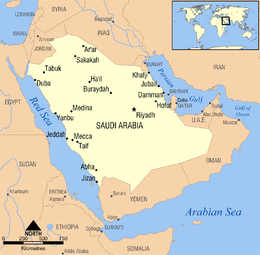
Back توحيد السعودية Arabic سعودی عرابیستانین بیرلشمهسی AZB সৌদি আরবের একত্রীকরণ Bengali/Bangla Unificación de Arabia Saudita Spanish Unification de l'Arabie saoudite French सउदी अरब का एकीकरण Hindi Penyatuan Arab Saudi ID Unificazione dell'Arabia Saudita Italian საუდის არაბეთის გაერთიანება Georgian 사우디아라비아의 통일 Korean
This article needs additional citations for verification. (September 2017) |
| History of Saudi Arabia |
|---|
 |
|
|
|
The Unification of Saudi Arabia was a military and political campaign in which the various tribes, sheikhdoms, city-states, emirates, and kingdoms of most of the central Arabian Peninsula were conquered by the House of Saud, or Al Saud. Unification started in 1902 and continued until 1932, when the Kingdom of Saudi Arabia was proclaimed under the leadership of Abdulaziz, known in the West as Ibn Saud, creating what is sometimes referred to as the Third Saudi State, to differentiate it from the Emirate of Diriyah, the First Saudi State and the Emirate of Nejd, the Second Saudi State, also House of Saud states.
The Al-Saud had been in exile in the British-protected Emirate of Kuwait since 1893, after their second episode of removal from power and dissolution of their polity, this time by the Al Rashid Emirate of Ha'il. In 1902, Abdulaziz Al Saud recaptured Riyadh, the Al Saud dynasty's former capital. He went on to subdue the rest of Nejd, al-Hasa, Jebel Shammar, Asir, and Hejaz (the location of the Muslim holy cities of Mecca and Medina) between 1913 and 1926. The resultant polity was named the Kingdom of Nejd and Hejaz from 1927 until it was further consolidated with al-Hasa into the Kingdom of Saudi Arabia in 1932.
It has often been claimed that this process caused some 400,000 to 800,000 casualties. However, recent research suggests that though bloody, the number of deaths and injuries was significantly lower.[16]
- ^ Peter W. Wilson, Douglas Graham. Saudi Arabia: the coming storm . M.E.Sharpe, 1994: p.45
- ^ Leatherdale, Clive. and Saudi Arabia, 1925–1939: the Imperial Oasis. p.115.
- ^ Chisholm, Hugh (25 March 2018). "The Encyclopedia Britannica: a dictionary of arts, sciences, literature and general information". The Encyclopedia Britannica Co.
- ^ Barmin, Yury. "How Moscow lost Riyadh in 1938". www.aljazeera.com.
- ^ "Karim Hakimov – "Red Pasha" and the Arabian Vizier of the Kremlin". islam-russia.com.
- ^ "The Story of the Shammar Tribe, the Indigenous Inhabitants of the Region". رصيف 22. 14 March 2018.
- ^ Almana 1982, p. 271.
- ^ Upbringing & Education 1902–1915 Archived 12 October 2017 at the Wayback Machine – The King Saud Foundation Website
- ^ Helmut Mejcher (May 2004). "King Faisal bin Abdulaziz Al Saud in the Arena of World Politics: A Glimpse from Washington, 1950 to 1971" (PDF). British Journal of Middle Eastern Studies. 31 (1): 5–23. doi:10.1080/1353019042000203412. S2CID 218601838. Archived from the original (PDF) on 9 May 2013. Retrieved 15 April 2012.
- ^ a b Al Kahtani, Mohammad Zaid (December 2004). "The Foreign Policy of King Abdulaziz" (PDF). University of Leeds. Retrieved 21 July 2013.
- ^ Sabri, Sharaf (2001). The House of Saud in commerce: A study of royal entrepreneurship in Saudi Arabia. New Delhi: I.S. Publications. ISBN 81-901254-0-0.
- ^ "الجيش السعودي.. من قوة «الإخوان» إلى القوة النظامية". Arsharq Al-Awsat. 9 October 2009. Archived from the original on 25 November 2015.
- ^ Murphy, David (2008). The Arab Revolt 1916-18: Lawrence Sets Arabia Ablaze. Osprey Publishing. p. 26.
- ^ Kostiner, Joseph (2 December 1993). The Making of Saudi Arabia, 1916–1936: From Chieftaincy to Monarchical State. Oxford University Press. pp. 170, 171. ISBN 9780195360707.
- ^ Cite error: The named reference
narrativewas invoked but never defined (see the help page). - ^ Eden, Jeff (2019). "Did Ibn Saud's militants cause 400,000 casualties? Myths and evidence about the Wahhabi conquests, 1902–1925". British Journal of Middle Eastern Studies. 46 (4): 519–534. doi:10.1080/13530194.2018.1434612. S2CID 149088619.
© MMXXIII Rich X Search. We shall prevail. All rights reserved. Rich X Search
